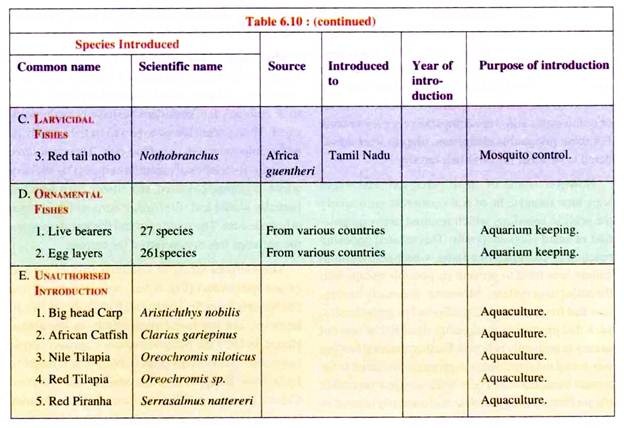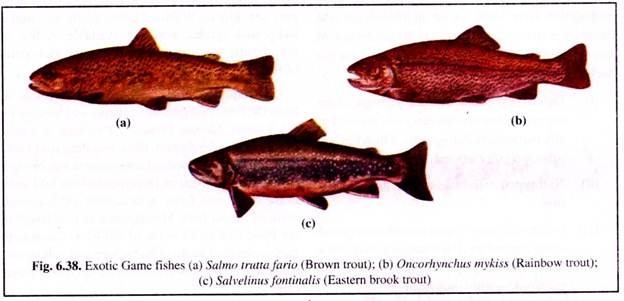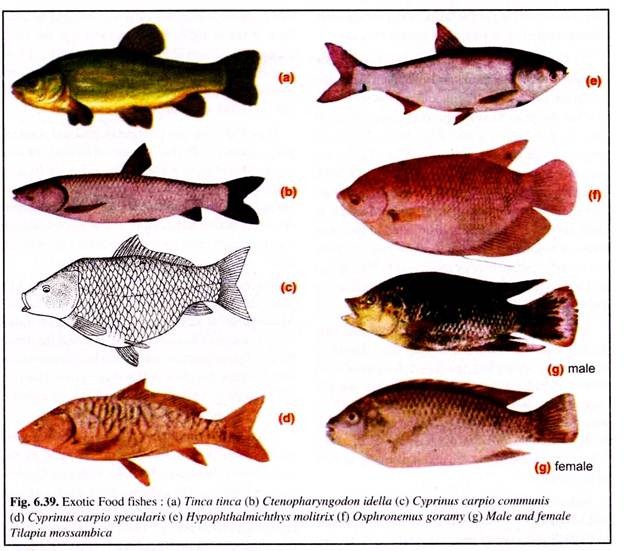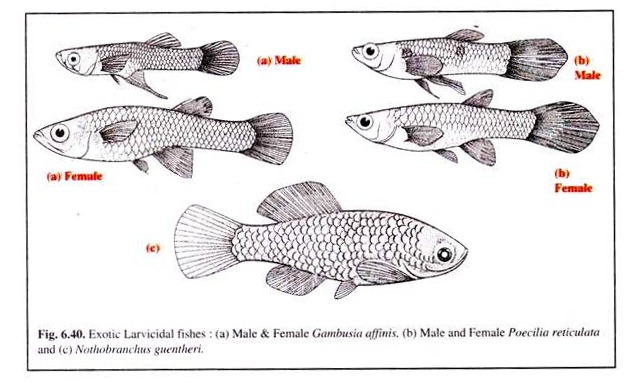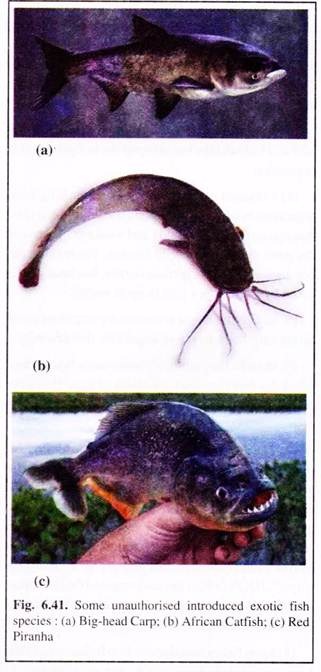In this article we will discuss about Exotic Fishes:- 1. Meaning of Exotic Fishes 2. Selection of Exotic Species 3. Culture 4. Merits and Demerits.
Meaning of Exotic Fishes:
Exotic fishes are those species that are non-indigenous having their origin in another country and has been introduced into the Indian waters. They generally have established culture technologies and the economics of production and marketability.
For such proven exotic species, there is a strong argument for their introduction and transplantation. But, the problem often faced is whether it is necessary to introduce such exotic species and what are the procedures and precautions to be taken to prevent probable undesirable consequences.
Past practices of indiscriminate introductions and transplantations for ornamental purposes and for biological control have had detrimental effects on the local fauna and have contributed to the spread of diseases. Thus, to prevent such consequences there is a need for following appropriate procedures and effective national regulations.
ADVERTISEMENTS:
However, for expanding aquaculture it is very difficult to avoid the introduction of such species for experimentation or commercial production.
Many such species (tilapia, common crap, Chinese carp, rainbow trout, Japanese and European oysters, etc.) have already colonized outside their geographical distribution range, the majority of them had been introduced for valid reasons. It is, however, a matter of question whether such successful introduction has been preceded by detailed screening procedures.
Selection of Exotic Species:
For introduction of exotic species Turner (1949) had suggested certain criteria.
The characteristics for the selection of exotic species are as follows:
ADVERTISEMENTS:
(1) Should be a fast grower, so as to compensate the dearth of protein.
(2) They should fulfill the need because of the absence of a similar desirable species in the locality.
(3) Such species should be compatible and should not compete with valuable native species leading to its decline.
(4) Should not undergo cross-breeding with native species and produce undesirable hybrids.
ADVERTISEMENTS:
(5) Should be devoid of pests, parasites or diseases, so that these may not attack the native species.
(6) Should live and reproduce in equilibrium with the new environment and should not cause any adverse ecological effects.
(7) Should be hardy, easy to handle and have other usefulness (multiple benefits). For example, grass carp clears the pond of weeds and its excreta fertilises the pond water.
(8) They should have proven technologies of culture and good economic viability.
Procedures and Precautions:
The above criteria hold good for introduction of exotic species but critical evaluations have to be done about the consequences of introductions. Data have to be obtained through experimental studies of the rationale for introduction, advantages and disadvantages of the candidate species and the assessment of impacts on the environment.
The results should be critically evaluated before the final decision is taken for general introduction or transplantation.
The procedures for the introduction should be on the following lines as recommended by the International Council for the Exploration of the Sea (ICES, 1979):
(1) In an approved quarantine environment, a brood stock of the species to be introduced should be established and sufficient time should be allowed for observation.
(2) The first progeny of this species should be examined thoroughly for any sign of diseases or parasites.
ADVERTISEMENTS:
(3) If these exotic species are parasite- or disease- free, then they are transplanted to the natural environment. Prior to introduction, all effluents of the quarantine units are disinfected in an approved manner.
(4) This introduced species in its new environment should be kept under constant and continued study and vigilance.
Predictions of ecological effects of the newly introduced species based on controlled experiments has many limitations. Such error can be minimized if the monitoring is carried out on a long-term basis and there would be sufficient time to adopt necessary measures.
Culture of Exotic Fishes and their Role:
The first batch of exotic fishes was introduced by Maclvor in 1874. He introduced two cold-water fishes, the tench (Tinea tinea) and golden carp (Carassius carassius), into the Ooty lake. Attempts to introduce these fishes into the plains have met with less success.
Subsequently, from time to time, a number of exotic species have been transplanted into the Indian waters to serve various purposes. A list of these has been given in Table 6.10.
A. Exotic Game Fishes:
Trout and salmon are the exotic game fishes that has been introduced in India. The initial introduction of trout in India was made during the latter half of nineteenth century and early twentieth century by the European residents of the country. Most of these attempts were not successful. It was in 1906 that Wilson succeeded on transplanting trout in Nilgiris and also putting its culture on a scientific footing.
The species of trout introduced are brown trout, Salmo trutta fario (Fig. 6.38a), rainbow trout Oncorhynchus mykiss (previous nomenclature; Salmo gairdneri gairdneri) (Fig. 6.38b), and eastern brook trout, Salvelinusfontinalis (Fig. 6.38c).
Trout culture is also practised in the north and its seeds have been introduced in lakes, streams and reservoirs. For its propagation a number of trout hatcheries have been set up in Nilgiris, Travancore (hill regions), Garhwal, Kashmir, Himachal Pradesh, etc.
Culture of trout mainly includes the following:
(i) Egg collection and artificial fertilisation by ‘dry method’.
(ii) Incubation of fertilised eggs.
(iii) Rearing of alevins and swim-up fry.
(iv) Production of fry and fingerlings.
(v) Rearing of adults for market as well as for further seed production (brood fishes).
Although a good number of hatcheries for trout propagation have been set up in Himalayan and Penin-sular states, the picture as to the production of trout is concerned, is not clear.
The causes for the decline of trout fishing are:
(i) Defective setting and hatchery design, where the glacier fed streams carry a heavy load of silt, particularly during rains, which leads to mass mortality of seeds.
(ii) Nutritional imbalance caused by malnutrition.
(iii) Infective diseases during incumbation period of the egg and fry. If left uncared, may cause heavy mortality resulting in losses to the trout propagation programmes.
(iv) Constraints in developing commercial farms. Lack of reliable data on cost benefit, finance, trained manpower, eco-biological and engineering research.
B. Exotic Food Fishes:
From time to time some exotic food fishes (Fig. 6.39) have been introduced into the Indian Waters (Table 6.10) as similar indigenous species were not available.
A few of these exotic species, important from the view point of fish culture, are discussed below:
(a) Tilapias:
Tilapias are natives of Africa. In India the first consignment of tilapia was brought by the Central Marine Fisheries Research Institute, Mandapam on 7th August, 1952 from Bangkok (Table 6.10, Fig. 6.39g). A second consignment was brought by the Madras Fisheries Department from Sri Lanka in the same year.
Later in December 1953, a small stock of tilapia from Mandapam was transferred to the Pond Culture Division of CIFRI at Cuttack, to make a detailed study of its biology and culture and the probable effect of its culture on the Indian major carps.
Jhingran and Gopalakrishnan (1974) have listed 22 species of tilapias that have been used for experimental culture or for aquaculture. Tropical aquaculturists were initially excited as these fishes were handy, could breed and be reared in almost any type of water (fresh, brackish or marine), were herbivorous or omnivorous and were comparatively easy to feed.
For these favourable characters, tilapias were considered to be ideal for rural fish farming.
However, some of these perceived advantages were later found to be of real constraint, particularly the prolific breeding, which resulted in overpopulation of small stagnant ponds. This created opposing reaction in countries like India, where restriction in culture was tried to prevent its possible escape into the major river systems.
Moreover, their early maturation and frequent breeding, affected its growth rates, such that producing marketable sized fishes was not as easy as originally believed. Further, external feeding was found to be necessary to produce fish suitable for human consumption. There were very few profitable tilapia farms during that time and naturally interest in tilapia culture dwindle for some time.
Later, due to efforts by enterprising farmers and advanced aquaculture techniques, interest in tilapia culture again rose to the effect that it began to be described as the future ‘aquatic chicken’. Despite tilapia being cultured presently on a profitable basis, due to easy workable technologies being available, still many problems have remained unsolved.
(b) Common Carps:
Cyprinus carpio, a native of China, is the worldwide most extensively cultivated species and is believed to be the earliest forms of fish to be cultured. It is considered to have been domesticated. Though considered to be a sport fish as well, its prime importance is as a food fish.
There are three recognised varieties of common carp:
(i) Scale carp which is orange coloured,
(ii) Mirror carp which is partially scaled, and
(iii) Leather carp which is virtually scale-less. The scale carp and the mirror carp are the varieties that are preferred for culture.
The German strain of common carp (Cyprinus carpio specularis) (Fig. 6.39d) was introduced into the Nilgiris from Sri Lanka in 1939 (Table 6.10). It, however, did not breed successfully in the plains. Hence, in 1957 the Bangkok strain, Cyprinus carpio communis (scale carp) (Fig. 6.39c), was brought to India from Bangkok and introduced into the Pond Culture Division of CIFRI at Cuttack.
Here, detailed investigations on various cultural aspects have been carried out. This strain breeds freely in the plains of India and has been distributed by CIFRI to the various states of the country for culture.
Although Cyprius carpio is exotic to India, it has already been cultivated singly and also along with Indian major carps. Its popularity in aquaculture is due to its efficiency in converting the food ingested into flesh, grows very fast and is prone to artificial feeds.
It is voraciously omnivorous, feeds on a wide variety of plant and animal matters, is non-predatory when cultured along with Indian major carps (competes for food somewhat with mrigal and kalbasu) and is apparently greater disease resistant.
The culture of common carp, however, has a shortfall in the fact that its habit of sucking food organisms in the mud on the pond bottom and margins makes the water muddy and weakens the base of pond dikes (an embankment for controlling or holding back the water and also serves as a causeway — a raised road or path between low or wet grounds).
This is why anglers consider common carp as a pest in sport waters. However, this habit of common carp can be greatly reduced if they are fed on artificial feedstuffs or processed feeds.
Another shortfall is the effect of common carp on the endemic cold-water fisheries of Kashmir, Himachal Pradesh, etc. The lakes of Kashmir, which once used to be full of native fauna with maximum members of snow-trouts (Schizothoracid) than anywhere else in India, are now full of common carp.
Not only the numbers have dwindled but also the size and weight of these much prized snow-trouts have gone down considerably over the years. The reasons for the decline of snow-trouts from the lacustrine systems are competition for food, the high fecundity of common carp, auto-spawning in the lakes, better fertilisation, shorter incubation period, high growth rate, etc.
(c) Grass Carp:
Grass carp Ctenopliaryngodon idella (Fig. 6.39b), is the natural inhabitant of the flat- land rivers of China and the middle and lower sections of river Amur in Russia. The first consignment of grass carp comprising 382 fingerlings (5.5 cm in length), which came to India from Hong Kong, was introduced into the Pond Culture Division of CIFRI, Cuttack in December, 1959.
In due course they were successfully bred by hypophysation at Cuttack in 1962 and the fry were then distributed to the other states of India. Gift consignments of grass carp fry were sent for culture to other countries like Philippines in 1964, Nepal in 1966 and Burma (Myanmar) in 1968.
Although a freshwater fish, grass carp can tolerate slightly brackish water. Grass carp has a toothless mouth but has strong and specialised pharyngeal teeth (which occurs in two rows) for rasping aquatic vegetation. It is, therefore, herbivorous and feeds on macrovegetation, including grass and aquatic plants. It starts feeding on macrovegetation when about 2.5-3.0 cm in length and can ingest plants up to 50% of its weight.
Although grass carp is not of high economic value, still it has been a popular species for aquaculture due to its ability to control macrovegetation. It is a fast grower, compatible and its excreta fertilises the pond water. Grass carp, however, when cultured with prawn, makes serious inroads in the habitat of prawn and the two thus cannot be said to be compatible (Sinha, 1978).
This species has acclimatised itself in Indian conditions and can breed even in weed-infested water bodies and can restrict the growth of economically important fishes. To prevent the breeding of this species efforts have been made to produce all-male grass carp by administration of methyltestosterone, however, with little success.
(d) Silver Carp:
Hypophthalmichthys molitrix or silver carp (Fig. 6.39e) is the native in the rivers of China and Amur basin of Russia. A consignment of 360 fingerlings of silver carp was brought to India from Japan in 1959. It was introduced to the Pond Culture Division of CIFRI at Cuttack, Odisha. These fingerlings after attaining maturity were bred successfully by Hypophysation and their fries were distributed to other states of India.
Hypophthalmichthys is a pelagophil and planktophagous species. The larval stages of this fish subsists on unicellular algae while the fry and adult feed on Flagellata, Dinoflagellata, Myxophyceae, Bacillario- phyceae. Protozoa and Rotifera along with decayed macrovegetation and detritus. It also thrives well on supplementary feeds such as bone meal, rice bran and flour.
Silver carp although a freshwater species, like grass carp, can tolerate slightly brackish water. Although silver carp is not of high economic value still it is cultured due to its ability to utilise the dense bloom of phytoplankton and its food conversion ratio is higher than that of the Indian major carps. This fish although of low-valued is suited for large-scale production to feed poor communities in rural areas.
(e) Giant Gourami:
The giant gourami, Osphronemus goramy (Fig. 6.39f), occurs naturally in the freshwaters of Indonesia, Thailand, Malaysia, Cambodia and Vietnam. The giant gourami was brought to Tamil Nadu from Mauritius in 1865, but it failed to establish itself. Later in 1916 it was successfully transplanted to Tamil Nadu from Java and Mauritius.
They can live in swampy conditions and breathe atmospheric oxygen through accessory respiratory organs. They easily spawn under pond conditions and are very palatable. The larvae feeds on plankton, while the adults subsist mainly on aquatic vegetation. Under emergency condition the fish is known to turn omnivorous feeding on insects, frog, small fishes, etc.
The giant gourami is a highly priced species. In spite of that, its earlier interest in culturing has diminished somewhat due to its slow growth rate and is now restricted to small-scale extensive farming.
(f) Tawes:
The tawes or Puntius javanicus cultivation is of little interest. It was introduced in India to determine its efficiency for weed control. In September 1972, a consignment of 500 fry was obtained from Indonesia and brought to the Kalyani Fish Farm, Kalyani (West Bengal) for observation under the All India Coordinated Project on Composite Fish Culture and Fish Seed Production.
Although the tawes and grass carp are used for weed control, P. javanicus, unlike grass carp, requires well oxygenated water for growth and survival. Therefore, tawes is unsuitale for culture in polluted waters. Thus, grass carp are better candidate for the eradication of weeds than the tawes.
C. Larvicidal or Larvivorous Exotic Fishes:
The term ‘larvivorous fishes’ comes in connection with its importance in controlling mosquito menace, as these fishes prefer insect larvae over other food. These fishes have little food value and are of immense importance in public health. They have been found to be cheaper, more effective and more permanent than artificial methods of mosquito conrol.
Larvicidal fishes should possess the following characteristics:
(1) They should be small, so that it can move about in shallow water among weeds.
(2) They should be hardy and flourish in deep shallow and foul waters.
(3) They should be prolific breeders and breed freely in confined water areas.
(4) They have suitably designed mouth so as to pick up eggs, larvae and pupae effectively in quick succession. The mouth is obliquely directed upwards. The lips are thin making the jaws work like a pair of forceps.
(5) They are top-feeders and carnivorous.
(6) They are generally compatible with the other fishes in that environment.
(7) They are difficult to catch and can evade or escape from their natural enemies.
(8) They are absolutely worthless and insignificant as food.
(9) They should be able to stand transport and handling.
For mosquito control, larvivorous fish should be introduced into a water body after clearing dense surface vegetation and removing predatory fishes, so as to allow the larvicidal fishes to establish themselves. The breeding place of mosquitoes is generally in shallow waters which is about 22.5 cm wide adjoining the bank. There are a number of indigenous and exotic species, which at one stage or the other feed on mosquito larvae.
The exotic species which have been in use in India (Table 6.10) are Ctenopharyn- godon idella, Carassius auratus, Poecilia reticulata (Fig. 6.40b), Gambusia affinis (Fig. 6.40a) and Notho- branchus guentheri (Fig. 6.40c). The latter three has been widely and effectively used. The world famous ‘guppy’ Poecilia reticulata and ‘mosquito fish’ Gambusia affinis are popular both in mosquito control as well as for aquarium.
Nothobranchus guentlieri, a native of east and central Africa, its small scale field introduction in certain parts of Tamil Nadu has been attempted. They have a very peculiar breeding habit for which they are called as ‘annuals’. This is because the habitat in which they live dry up annually and before it does so, Nothobranchus deposits drought resistant eggs in the mud.
When the rain sets in, the mud-embedded eggs hatch and acquire maturity within a year. They are probably the fastest known grower among fishes as they grow from egg to adult in four weeks’ time. Their introduction into any impoundment does not have any adverse effect on the local fauna. Once Nothobranchus has established itself, malaria is likely to be controlled.
Merits and Demerits of Exotic Fishes:
Along with anthropogenic activities, the depletion of freshwater aquatic biodiversity has also been reported to have been caused by the introduction of exotic species. Introduced (exotic) species are those that have been intentionally or accidentally transported and released by man outside its present range.
It has been reported that 168 species of fishes, representing 37 families have been worldwide introduced outside their natural distribution range, Of these, a minimum of 67 species have become established in different water bodies and of it, 27 species have turned out to be real pests.
In India several exotic species of fishes have established themselves in natural water bodies. Studies on their impact in Indian waters have been carried out, which have revealed unequivocally the devasting impacts of these exotic fishes (such as Tilapia, Silver Carp, Gambusia, common carp, etc.) in Indian aquatic ecosystems.
Some of their merits and demerits are discussed below:
I. Merits of Exotic Fishes:
Although India has an array of indigenous species (about 637 fish species), yet a number of exotic species has been introduced due to their extraordinary merit wich is absent in the indigenous species or to increase the beauty of aquarium.
Fishes has been introduced mainly in two ways:
(a) Scientists of the fisheries department who often investigating the pros and cons found it to be suitable for introduction which would be beneficial to fishers.
(b) Unauthorised introduction either by:
(i) The fishers who to gain economical milage have introduced the fishes (evading the government outline), or
(ii) Through any small water outlet and accidental release through the agency of fish-eating binds and mammals.
The beneficial impacts of exotic fishes are summed up as follows:
(1) The exotic carps, due to their fast growth rate (high food conversion ratio), have become good candidates for the composite fish culture practice. They contribute handsomely to the yield and can solve the scarcity of protein in India. Grass carp has been reported to have attained a weight of 5 kg in a year.
(2) Common carp can be made to breed in confined waters of pond and thus, the farmers need not go to the rivers for their seed collection during the breading season.
(3) Common carp being omnivorous and a scavenger, keeps the water of an impoundment (pond) clean and pollution-free.
(4) Silver carp in Indian warmer condition, matures at the age of one, while in its native habitat it matures at the age of 5-6 years.
(5) Silver carp has the ability to utilise the dense bloom of phytoplankton and help in keeping it under check.
(6) Grass carp can feed on a wide range of aquatic vegetation and is used for controlling of weeds.
(7) The excreta of grass carp contain semidigested food which serves as food for omnivorous fishes and also serves in fertilising the pond water.
(8) About 288 species of beautifully coloured exotic ornamental fishes are very popular among the aquarists.
(9) The larvicidal fishes (Guppy, Gambusia affinis) have been introduced for mosquito control.
(10) The game fishes (trout and salmon) have been planted in hill streams, lakes and reservoirs for leisure time angling.
(11) Puntius javonicus was unauthorisedly introduced in India for culturing in rice fields.
(12) Tilapia, often called as ‘super-fish’ and considered as ‘chicken of water’, breeds easily (has high fecundity), cheap to feed, can tolerate wide range of temperature and salinity. They are comparatively free from parasites and diseases. Due to their hardy nature they are ideally suited for culture in sewage- fed ponds.
(13) Tilapia needs less management for culture as they can feed on a wide range of food, attain maturity within 2 months, can breed in confined waters and have good parental care.
II. Demerits of Exotic Fishes:
The indiscriminate introduction of exotic fishes has brought about a number of problems. Not many studies have been carried out on the impacts of exotic species in Indian waters. However, reports from elsewhere provide a bleak scenario of the damages caused by such introduction, which is true to Indian conditions.
Some of the disadvantages encountered are listed below:
(1) The introduction of African Cichlid (Tilapia) in India has been claimed by many experts as a successful event. However, unanticipated impact on both freshwater and brackish water fisheries has now been felt. Being a prolific breeder and hardy in nature, Tilapia has overcrowded many water bodies, resulting in prevention of growth of IMC in pond waters.
(2) Introduction of Tilapia in Bharathapuzha (the longest river in Kerala) has resulted in replacing native fish fauna in many areas. It has also been reported that frequent gill net fishing’s to collect Tilapias have resulted in disappearance of freshwater turtles in certain water bodies.
(3) The introduction of Cyprinus carpio into Dal lake and Loktak lake has affected the indigenous fish population.
(4) Common carp has the habit of sucking food organisms in the mud on the pond bottom and margins, that makes the water muddy and weakens the base of the pond dyke, resulting in erosion. For making the pond water muddy, cyprinus carpio, has been considered by anglers as a pest in sport waters.
(5) In Govind Sagar reservoir the introduction of Silver carp has a negative impact on fish diversity.
(6) In India the culture of exotic carps is uneconomical due to its low cost. The flesh of these fishes are poor in quality or have undesirable grass-smell (grass carp).
(7) The introduction of Guppy and Mosquito Fish (Gambusia) in India has a negative impact on aquatic biodiversity. The Mosquito Fish are hardy and prolific breeders, and are capable of entering into the microhabitats of rare native species and have been reported as predators.
The famous Ichthyologist Mayer (1965) labelled this species as a “fish destroyer”. IUCN (1986) has also reported that the cause of extinction of a number of species worldwide has been due to introduction of Guppy.
(8) Sport fishes introduction into Indian waters has been considered previously as non-problematic. At present trouts have been reported not only to compete with native stocks but also have been found to be a major predator (Rainbow Trout) on the eggs and young ones of native species.
(9) The fishes illegally imported to India consist of the carnivorous and voracious feeders such as the Big-head Carp (Aristichthys nobilis Fig. 6.41a) and the African Catfish (Clarius gariepinus Fig. 6.41b), and the aquarium fish, the Red Piranha (Serrasalmus nattereri Fig. 6.41c). These exotic fishes in natural water bodies have become a very serious threat to the smaller indigenous fish species as well as invertebrates.
The threat posed by these fishes has led the Union Agriculture Ministry to order the killing of these fishes en masse. However, such Government order has failed to have any impact. Even today the African catfish and piranhas have been bred in the farms of West Bengal and Kerala.
(10) Along with the introduction of exotic fishes, transfer of parasites and diseases has also been reported from the Indian waters. This may lead to the formation of much dangerous mutated forms.
(11) Introduction of exotic fishes to different habitats in India may also lead to loss of biodiversity.
Thus, it can be concluded that exotic fishes not only compete with indigenous species for food and habitat, they may even be preyed upon. The exotic species introduce new parasites and diseases, resulting the production of hybrids and causing genetic ‘erosion’ of indigenous species and degradation of the physico-chemical nature of aquatic ecosystem.
All these subsequently will lead to the loss of biodiversity. The potential risk also affects the socio economic aspects of the human community, as they depend upon the aquatic ecosystem for their sustenance.

